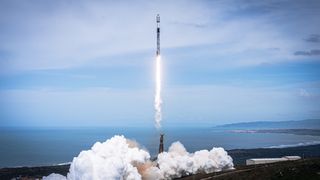
A SpaceX Falcon 9 rocket launches 52 Starlink satellites from California’s Vandenberg Space Force Base on March 17, 2023.
(Image credit: SpaceX)
SpaceX has a very busy evening planned.
Elon Musk’s company aims to launch three of its Falcon 9 rockets today (March 30), an intense surge of orbital action from both coasts that could take place in a roughly five-hour stretch.
One of the rockets is scheduled to launch the Eutelsat 36D telecommunications satellite to geostationary transfer orbit from NASA’s Kennedy Space Center in Florida, during a four-hour window that opens at 5:52 p.m. EDT (2152 GMT).
Up next are two missions devoted to building out SpaceX’s Starlink broadband megaconstellation in low Earth orbit (LEO). One will send 23 Starlink satellites aloft from Florida’s Cape Canaveral Space Force Station during an hourlong window that opens at 9:02 p.m. EDT (0102 GMT on March 31). The other will send 22 Starlink craft up from Vandenberg Space Force Base in California, during a four-hour window that opens at 10:30 p.m. EDT (7:30 p.m. California time; 0230 GMT on March 31).
You can watch all three launches via SpaceX’s account on X. Coverage of the Eutelsat 36D mission will begin about 15 minutes before the window opens, and coverage of the Starlink flights will commence about five minutes before their respective windows open.
Related: Starlink satellite train: How to see and track it in the night sky
All three launches will feature rocket landings on ships at sea; in each case, the Falcon 9’s first stage will touch down about 8.5 minutes after liftoff.
Breaking space news, the latest updates on rocket launches, skywatching events and more!
It will be the 12th landing for the Eutelsat 36D Falcon 9, and the 18th and 15th landings for the rockets launching the two Starlink missions.
Once it’s up and running in geostationary orbit about 22,000 miles (35,400 kilometers) above Earth, Eutelsat 36D will provide TV broadcasting services to customers in Europe, Russia and Africa, according to EverydayAstronaut.com.
The 45 satellites going up on today’s two Starlink flights, meanwhile, will join more than 5,600 of their operational broadband brethren in LEO.
SpaceX already has experience with back-to-back-to-back launches. Just last month, the company launched a batch of Starlink satellites, the classified USSF-124 mission for the U.S. Space Force and the IM-1 private moon-landing mission in less than 24 hours.
All three of those missions involved Falcon 9 rockets as well.
Join our Space Forums to keep talking space on the latest missions, night sky and more! And if you have a news tip, correction or comment, let us know at: [email protected].
Michael Wall is a Senior Space Writer with Space.com and joined the team in 2010. He primarily covers exoplanets, spaceflight and military space, but has been known to dabble in the space art beat. His book about the search for alien life, “Out There,” was published on Nov. 13, 2018. Before becoming a science writer, Michael worked as a herpetologist and wildlife biologist. He has a Ph.D. in evolutionary biology from the University of Sydney, Australia, a bachelor’s degree from the University of Arizona, and a graduate certificate in science writing from the University of California, Santa Cruz. To find out what his latest project is, you can follow Michael on Twitter.
>>> Read full article>>>
Copyright for syndicated content belongs to the linked Source : Space.com – https://www.space.com/spacex-launch-tripleheader-march-2024































